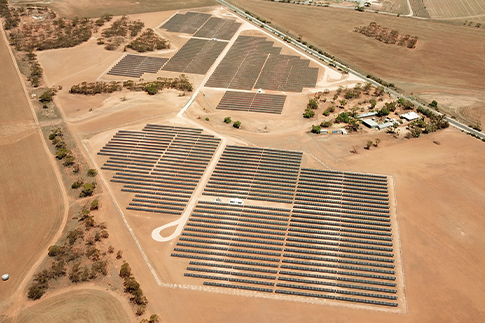The Mannum Solar Farm Project in South Australia’s Mid-Murray region is complete. Chinese-Canadian solar giant Canadian Solar contracted MPower for the 6.8MW (DC) section of the larger 30MW large-scale solar farm in June 2019.
MPower has said that it is especially targeting small-scale solar farms, and for good reason, small-scale utility solar farms are relatively easier to connect to the grid, an increasing cause of frustration for the nation’s energy transition. South Australia, in particular, is experiencing a surge in small-scale utility solar farms. Indeed, MPower announced that it is already hard at work on a further two grid-connected solar farm projects.
The Mannum project consisted of some 17,000 single-axis tracking panels, and MPower’s CEO Nathan Wise believes the project marks a milestone for the company as a renewable energy integrator. “With three solar farms of this size now completed and a further two new solar farms underway,” said Wise, “MPower has proven capability and is well-positioned to benefit from the future growth in this sector.”
MPower broke ground on the two above-mentioned under-construction solar farms in January 2020. The two 5 MW projects are being developed by Astronergy solar Australia. “MPower has developed an enviable capability in the successful delivery of 5MW solar farms and continues to strengthen its order book in the growing renewable sector,” said Wise.
Small-Scale Utility Solar Surge
Network conditions have continued to deteriorate around Australia. Congestion has become such a cause of frustration that the Victorian Government has now decided to break away from national electricity rules. The Andrews Government has introduced legislation to fast-track priority projects and transmission upgrades to ensure large-scale renewables can more easily connect to the grid.
Clean Energy Council CEO Kane Thornton said that “Our transmission network has simply not kept pace with the transition to a 21st-century energy system and is causing major concerns for investors in clean energy.”
“Over the last year we have seen a massive 50% decrease in large-scale renewable energy investment,” continued Thornton, “and we know that the lack of investment in transmission is the single biggest factor preventing the deployment of new generation projects.”
Last September, AEMO constrained the output of five large-scale solar generators by 50%, including four solar farms located in north-west Victoria: Gannawarra, Karadoc, Wemen and Bannerton; and Broken Hill in NSW. NEM-wide solar and wind curtailment reached a record high of 6% of total output in Q4 2019, according to AEMO data. This happened mainly due to self-curtailment in response to negative prices, system security constraints on five solar farms in Victoria and NSW, system strength constraints in South Australia, and transmission outages and other network constraints.
These constraints and the lassitude of regulators and policymakers to transition our network into the 21st-century is driving a surge in smaller-scale solar farms, particularly around the 5MW mark. At this size, projects do not face the same constraints or overheads of large-scale projects. For South Australia and Victoria, these projects may prove the path of least resistance until transmission upgrades, such as the SA-NSW interconnector, can unlock the gigawatts of planned renewable energy developments.
This content is protected by copyright and may not be reused. If you want to cooperate with us and would like to reuse some of our content, please contact: editors@pv-magazine.com.









2 comments
By submitting this form you agree to pv magazine using your data for the purposes of publishing your comment.
Your personal data will only be disclosed or otherwise transmitted to third parties for the purposes of spam filtering or if this is necessary for technical maintenance of the website. Any other transfer to third parties will not take place unless this is justified on the basis of applicable data protection regulations or if pv magazine is legally obliged to do so.
You may revoke this consent at any time with effect for the future, in which case your personal data will be deleted immediately. Otherwise, your data will be deleted if pv magazine has processed your request or the purpose of data storage is fulfilled.
Further information on data privacy can be found in our Data Protection Policy.